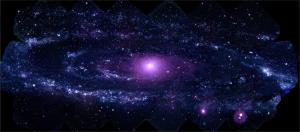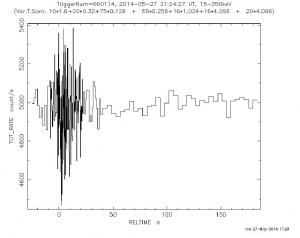Blog
Rumor Weed
29 May 2014
 NASA/Swift/Stefan Immler (GSFC) and Erin Grand (UMCP)
NASA/Swift/Stefan Immler (GSFC) and Erin Grand (UMCP)Yesterday there was a flurry of news about a gamma ray burst (GRB) appearing in the Andromeda galaxy. This would make it the closest observed gamma ray burst, which would be a boon for astronomers. News of this discovery travelled fast, particularly on Twitter and other social networks. Pretty soon a few news sites had picked up the story. But it turns out it wasn’t a gamma ray burst.
It all started with a space telescope known as Swift. Swift is designed to study gamma ray bursts, and one of its detectors is a wide field telescope known as the Burst Array Telescope (BAT). The BAT is designed to look for bursts of high energy radiation from unknown sources. If it detects one, it “triggers” and sends an alert so that other telescopes can be position to observe the event. Gamma ray bursts can be short lived, so time is of the essence.
Normally the level needed for the BAT to trigger is pretty high (6.5 sigma for you statisticians) so that it doesn’t cry wolf all the time (what are known as spurious events). But the bar is set a bit lower if the energy burst seems to be from a nearby galaxy. So Tuesday night (EDT) BAT detected a burst, and Swift’s x-ray telescope also observed a burst of x-rays. The burst also happened to be in the direction of the Andromeda galaxy. So it triggered and the alert went out.
 Goddard Space Flight Center/NASA
Goddard Space Flight Center/NASANaturally, some of the astronomers working in this area of research use Twitter, and started tweeting about a possible GRB in Andromeda. This was picked up by their fans and other astronomers, and the whole thing cascaded. It turns out it was a known x-ray source, probably an x-ray binary. So while it initially looked promising, it turned out to be a spurious event. Sometimes this happens, and it is better to have the occasional false alarm rather than miss an important event.
Of course all of this played out in the social media circles, and its seems rather chaotic at the time. It also means sometimes things get reported as far more certain than they actually are. If you actually look at what is being said, however, you’ll see something rather interesting. If you go back and look at the comments, such as those tagged with #GRBM31 on Twitter, you’ll notice that the astronomers are pretty careful about saying things like “possible” GRB. They spread the tentative news, and start looking for evidence to confirm or deny the event. As they learn things from a clear source, they start tweeting that as well. You’ll also note there is a great deal of excitement.
This is part of what makes science interesting. Cool things happen, even if we later find out it isn’t as cool as we thought.